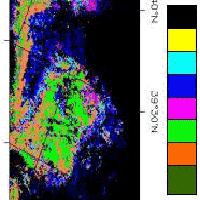
Calibration assessment of forest flammability potential in Italy
Piermaria Corona (1), Barbara Ferrari (2), Rosaria Cartisano (2), Anna Barbati (2)
iForest - Biogeosciences and Forestry, Volume 7, Issue 5, Pages 300-305 (2014)
doi: https://doi.org/10.3832/ifor1123-007
Published: May 07, 2014 - Copyright © 2014 SISEF
Research Articles
Abstract
Fuel flammability is defined as the relative ease with which a fuel will ignite and burn with a flame; different forest types have different intrinsic “baseline” flammabilities, depending on the susceptibility to burn of the main tree species that build up the forest cover. In this perspective, we apply a forest-type based approach to classify and map the flammability level of the forests in Italy. Baseline forest type-based flammability values provided at European level have been assigned to a national forest types map, derived from Corine Land Cover 2006; flammability values have been then further calibrated against the Burned Area Selection Ratio, a measure of the actual incidence of wildfires among different forest types. Accordingly, a calibrated flammability index was derived by simple linear regression, so that predicted flammability more accurately reflects observed fire incidence among different forest types in Italy. Findings show that the flammability of forest types ranges from low to high: on average, the 17% of the forest cover has medium to high flammability, with wide regional variability; notably, in four Regions (Sardegna, Sicilia, Puglia, Calabria) over one third of total forest area has medium to high flammability. Large scale mapping of forest flammability is crucial to define long-term priorities among forest areas as to how to distribute fire management effort: areas falling into medium to high flammability classes should be given priority for implementing fuel management treatments in order to mitigate fire hazard from the stand to the landscape scale.
Keywords
Fuel Flammability, Fire Hazard, European Forest Types, Burned Area Selection Ratio, Fire Management
Authors’ Info
Authors’ address
Consiglio per la Ricerca e la sperimentazione in Agricoltura, Forestry Research Centre (CRA-SEL), v.le S. Margherita 80, Arezzo (Italy)
Rosaria Cartisano
Anna Barbati
Department for Innovation in Biological Agro-food and Forest systems (DIBAF), University of Tuscia, via San Camillo de Lellis snc, I-01100 Viterbo (Italy)
Corresponding author
Paper Info
Citation
Corona P, Ferrari B, Cartisano R, Barbati A (2014). Calibration assessment of forest flammability potential in Italy. iForest 7: 300-305. - doi: 10.3832/ifor1123-007
Academic Editor
Raffaele Lafortezza
Paper history
Received: Sep 10, 2013
Accepted: Mar 06, 2014
First online: May 07, 2014
Publication Date: Oct 01, 2014
Publication Time: 2.07 months
Copyright Information
© SISEF - The Italian Society of Silviculture and Forest Ecology 2014
Open Access
This article is distributed under the terms of the Creative Commons Attribution-Non Commercial 4.0 International (https://creativecommons.org/licenses/by-nc/4.0/), which permits unrestricted use, distribution, and reproduction in any medium, provided you give appropriate credit to the original author(s) and the source, provide a link to the Creative Commons license, and indicate if changes were made.
Web Metrics
Breakdown by View Type
Article Usage
Total Article Views: 55567
(from publication date up to now)
Breakdown by View Type
HTML Page Views: 46727
Abstract Page Views: 2894
PDF Downloads: 4492
Citation/Reference Downloads: 60
XML Downloads: 1394
Web Metrics
Days since publication: 4229
Overall contacts: 55567
Avg. contacts per week: 91.98
Citation Metrics
Article Citations
Article citations are based on data periodically collected from the Clarivate Web of Science web site
(last update: Mar 2025)
Total number of cites (since 2014): 18
Average cites per year: 1.50
Publication Metrics
by Dimensions ©
Articles citing this article
List of the papers citing this article based on CrossRef Cited-by.
References
Fires and ecosystem complexity. From forest assessment to habitat restoration. Executive summary. Ministero dell’Ambiente e della Tutela del Territorio, Società Botanica Italiana, Palombi & Partner, Rome, Italy, pp. 60.
Gscholar
Gestione selvicolturale dei combustibili per la prevenzione degli incendi boschivi [Silvicultural management of forest fuels to prevent wildfires]. Compagnia delle Foreste, Arezzo, Italy, pp. 208. [in Italian]
Gscholar
Rapporto annuale incendi boschivi [Annual report on forest fires]. Corpo Forestale dello Stato, Rome, Italy.
Gscholar
Stochastic gradient boosting classification trees for forest fuel types mapping through airborne laser scanning and IRS LISS-III imagery. International Journal of Applied Earth Observation and Geoinformation 25:87-97.
CrossRef | Gscholar
Le stime di superficie 2005. Prima parte. Inventario Nazionale delle Foreste e dei Serbatoi Forestali di Carbonio [Area estimates 2005. National Inventory of Forests and Forest Carbon Sinks] (Tabacchi G, De Natale F, Di Cosmo L, Floris A, Gagliano C, Gasparini P, Genchi L, Scrinzi G, Tosi V eds). MiPAF - Corpo Forestale dello Stato - Ispettorato Generale, CRA-ISAFA, Trento, Italy, pp. 413. [in Italian]
Online | Gscholar
I caratteri quantitativi 2005 - Prima parte, versione 2. Inventario Nazionale delle Foreste e dei Serbatoi Forestali di Carbonio [The quantitative attributes 2005. National Inventory of Forests and Forest Carbon Sinks] (Gasparini P, De Natale F, Di Cosmo L, Gagliano C, Salvadori I, Tabacchi G, Tosi V eds). MiPAAF - Ispettorato Generale Corpo Forestale dello Stato, CRA-MPF, Trento, Italy.
Online | Gscholar
La realizzazione in Italia del progetto Corine Land Cover 2006 [The implementation in Italy of the project Corine Land Cover 2006]. Istituto Superiore per la Protezione e la Ricerca Ambientale, Report no. 131, Rome, Italy, pp. 49. [in Italian]
Gscholar
Fire management and prevention policies in west Mediterranean pine forests. In: “Ecology, Biogeography and Management of Mediterranean Pine Forest Ecosystems (Pinus halepensis and P. brutia)” (Ne’eman G, Trabaud L eds). Backhuys Publishers, The Hague, The Netherlands, pp. 335-354.
Gscholar
Inflammabilité et combustibilité des principales espèces des garrigues de la region méditerranéennes [Flammability and combustibility of the main species of the garrigues in the French Mediterranean region]. Oecologia Plantarum 11 (2): 117-136. [in French]
Gscholar
Fire hazard and flammability of European forest types. In: “Post-fire management and restoration of Southern European forests” (Moreira F, Arianoutsou M, Corona P, De Las Heras G eds). Managing Forest Ecosystems 24, Springer, Berlin, Germany, pp. 79-92.
Gscholar

















